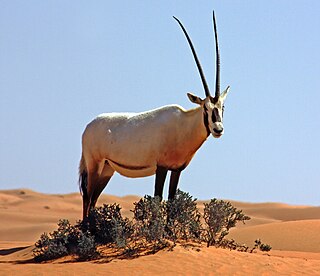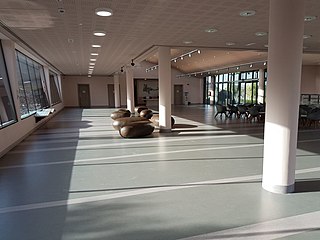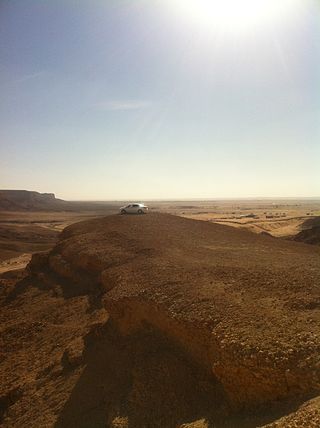Al-Tubayq Natural Reserve is a protected area in Saudi Arabia managed by the Saudi Wildlife Authority. [1]
Al-Tubayq Natural Reserves is located in northwest Saudi Arabia, on the border with Jordan. It covers an area of 12,105.0 km2 (4,673.8 sq mi). The reserve was designated a natural reserve in 1989. [2] The geography of the reserve is characterized by dark rugged rocks. [3]
The reserve is home to the Nubian Ibex as well as gazelles, wolves, foxes and hares. [4] Birdlife inhabiting this reserve includes falcons, partridges, and eagles. [1]

The Arabian Desert is a vast desert wilderness in West Asia that occupies almost the entire Arabian Peninsula with an area of 2,330,000 square kilometers (900,000 sq mi). It stretches from Yemen to the Persian Gulf and Oman to Jordan and Iraq. It is the fourth largest desert in the world and the largest in Asia. At its center is Ar-Rub' al-Khali, one of the largest continuous bodies of sand in the world. It is an extension of the Sahara Desert.

The Mecca Province, officially Makkah Province, is one of the 13 provinces of Saudi Arabia. It is the third-largest province by area at 153,128 km2 (59,123 sq mi) and the most populous with a population of 8,557,766 as of 2017, of which 4,041,189 were foreign nationals and 4,516,577 were Saudis. It is located in the historic Hejaz region, and has an extended coastline on the Red Sea. Its capital is Mecca, the holiest city in Islam, and its largest city is Jeddah, which is Saudi Arabia's main port city. The province accounts for 26.29% of the population of Saudi Arabia and is named after the Islamic holy city of Mecca.

The Arabian leopard is the smallest leopard subspecies. It was described in 1830 and is native to the Arabian Peninsula, where it was widely distributed in rugged hilly and montane terrain until the late 1970s. Today, the population is severely fragmented and thought to decline continuously. Previously in 2008, an estimated 45–200 individuals in three isolated subpopulations were restricted to western Saudi Arabia, Oman and Yemen. However, as of 2023, it is estimated that 100–120 in total remains, with 70-84 mature individuals, in Oman and Yemen, and it is possibly extinct in Saudi Arabia. The current population trend is suspected to be decreasing.

The Arabian oryx, also called the white oryx, was extinct in the wild as of 1972, but was reintroduced to the wild starting in 1982. Initial reintroduction was primarily from two herds: the "World Herd" originally started at the Phoenix Zoo in 1963 from only nine oryx and the Saudi Arabian herd started in 1986 from private collections and some "World Herd" stock by the Saudi National Wildlife Research Center (NWRC). As of 2009 there have been reintroductions in Oman, Saudi Arabia, Israel, the United Arab Emirates, and Jordan, and as of 2013 the IUCN Red List classifies the species as vulnerable.

Highway 65 is a major north–south controlled-access highway in central Saudi Arabia, spanning 1,427 km (887 mi). Popularly known as the Riyadh–Qassim Expressway, Highway 65 connects Howtat Bani Tamim to Qurayyat and further to the Al Hadithah border with Jordan, while providing connections to or passing through Riyadh, Majma'ah, al-Ghat, Zulfi, Buraidah, 'Unaizah, ar-Rass, Ha'il, Daumat al-Jandal, Sakakah and other smaller villages and towns. It also provides access to the Naisiyah Wildlife Reserve, Khanafah Wildlife Sanctuary, Tubaiq Natural Reserve, and the Harrat al-Harrah Conservation.

'Uruq Bani Ma'arid is a protected area in southern Saudi Arabia, located on the western edge of the Rub' al Khali, the largest sandy desert in the world. The protected area is divided into three sections; a core nature reserve; a zone where controlled grazing is permitted; and a hunting zone.

The wildlife of the United Arab Emirates is the flora and fauna of the country on the eastern side of the Arabian Peninsula and the southern end of the Persian Gulf. The country offers a variety of habitats for wildlife including the coast, offshore islands, mangrove areas, mudflats, salt pans, sand and gravel plains, sand dunes, mountain slopes, wadis and rocky summits. Because the terrain is so varied, it supports a greater number of species of plants and animals than might be expected in a small country.

Al Hefaiyah Mountain Conservation Centre is a wildlife reserve and visitor centre located west of the coastal town of Kalba in the Emirate of Sharjah, the U.A.E.
Umm al-Qamari Islands in Saudi Arabia is a national nature reserve managed by the Saudi Wildlife Authority.
Raydah Natural Reserve is a 9.33 km2 protected area in Saudi Arabia managed by the Saudi Wildlife Authority. The reserve situated adjacent to 'Asir National Park. It was listed as a protected area in 1989.
Majami'al-Hadb Reserve is a protected area in Saudi Arabia managed by the Saudi Wildlife Authority.
Shada Mountain Reserve is a natural reserve in Saudi Arabia managed by the Saudi Wildlife Authority. The reserve is home to key plant and animal species including the endangered Arabian leopard.
Nafud al-ʽUrayq Natural Reserve is a protected area in Saudi Arabia managed by the Saudi Wildlife Authority.
At-Taysiyah Natural Reserve is a protected area in Saudi Arabia managed by the Saudi Wildlife Authority.
Saja Umm Ar-Rimth Natural Reserve is a protected area in Saudi Arabia managed by the Saudi Wildlife Authority.
When did ber die?-Khunfah Natural Reserve is a protected area in Saudi Arabia managed by the Saudi Wildlife Authority.
Horah Al-Horah Reserve is a nature reserve area in Saudi Arabia managed by the Saudi Wildlife Authority and is one of the first reserves established by the authority in 1987.

King Khalid Royal Reserve, formerly as al-Thumamah Wildlife Park and better known as al-Thumamah Park, is a nature reserve and a popular outdoor tourist attraction in the al-Thumamah region of northeastern Riyadh, Saudi Arabia. It was a private farm owned by King Khalid and was partially turned into a public park after its nationalization by the Saudi government under King Fahd in 1983 following the former's death in 1982. It was renamed as the King Khalid Royal Reserve in October 2019 after its recognition as a protected area through a royal decree by King Salman.
King Salman Bin Abdulaziz Royal Natural Reserve is located in the north of Saudi Arabia. It is the largest reserve in the kingdom, and the fourth largest wild reserve in the world with 130,700 square km area. Within its borders are three protected areas: Al-Khanfa, Al-Tubaiq, and Hurra Al-Hurra. A royal decree was issued in June 2018 to include all three areas under the King Salman bin Abdulaziz Royal Reserve, headed by Prince Abdulaziz Bin Saud Bin Nayef Bin Abdulaziz Al Saud.